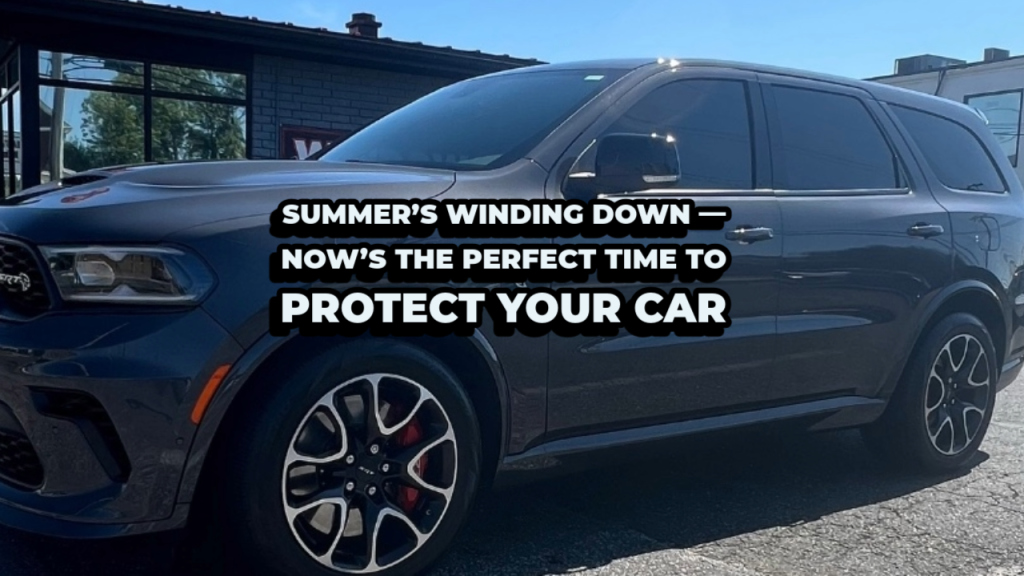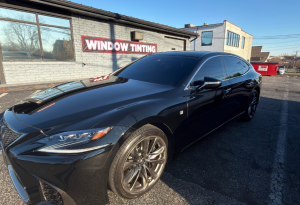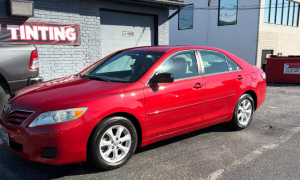Nobody wants summer to end. The long days, dry roads, and that showroom shine are easy to love. But as the calendar flips toward fall, your vehicle faces a new set of threats: falling leaves, heavy rains, early frosts, grit from road repairs, and the salt that arrives with the first snow. Those conditions accelerate paint wear, promote corrosion, and make cosmetic damage more likely.
If you’ve been thinking about ceramic coating or paint protection film (PPF), the next few weeks are prime time to get it done. Here’s why acting now — while the weather is still cooperative — protects your car better and saves you time and money when winter arrives.
Why fall is the smart window for protection work
Timing matters. Ceramic coatings and PPF are durable, long-lasting investments, but both require proper installation conditions and curing time:
- Warm, dry conditions help coatings and film set correctly. Many ceramic products and adhesives perform best when humidity is moderate and temperatures are above freezing. Late summer and early fall typically offer those ideal conditions.
- You’ll seal out summer damage before winter stressors begin. Windblown sand, bug acids, sun oxidation and tree sap do cumulative harm. Treating now means you start winter with a fresh, protected finish rather than repairing damage later.
- Avoid service delays. Installers are busiest in spring and early summer. Booking now helps you avoid the pre-winter rush and lock in an appointment before colder weather complicates installs.
Ceramic coating vs. PPF — what each does (and why many owners choose both)
Ceramic coating is a liquid polymer that bonds to the clear coat and provides chemical resistance, UV protection, and hydrophobic performance. Its strengths for fall/winter:
- Shields clear coat from oxidation and UV fading.
- Makes roadsalt, bird droppings and grime easier to remove.
- Improves gloss and reduces wash frequency — useful when you don’t want to wash in cold weather.
- Extends the time between full details.
Paint Protection Film (PPF) is a thicker clear urethane that provides physical impact resistance:
- Protects from chips, rock strikes and abrasive grit — common at the start of fall when road repairs and loose gravel increase.
- Self-healing films can recover from light scratches with heat exposure.
- Ideal for high-risk zones: front bumper, hood, fenders, mirrors, door edges.
- When combined with a ceramic topcoat, PPF gains added chemical resistance and hydrophobicity.
Best practical approach: If your budget allows, a front-end PPF package plus a ceramic coating on top gives comprehensive defense: mechanical impact protection where you need it, plus long-term chemical and hydrophobic benefits across the vehicle.
Concrete benefits you’ll notice this winter
- Less paint damage from salt and grit. PPF and ceramic coatings reduce the chance of chips turning into rust spots after repeated exposure to salt.
- Easier, safer winter cleanups. Hydrophobic surfaces bead water and slush, so roadside washes or quick rinses remove contaminants faster.
- Lower lifetime maintenance costs. Preventing minor damage avoids expensive paint repairs and keeps resale value high.
- Better visibility and safety. Coatings on headlights and glass treatments keep light output higher and reduce buildup of grime on lenses.
- Peace of mind. Leave your car parked outside or in a public lot with added confidence that the finish is protected.
What to expect from a professional installation (and why it matters)
Proper installation matters more than brand names. Here’s what a professional will do that DIY can’t reliably replicate:
- Thorough prep: Washing, decontamination (clay or iron remover), and paint correction if necessary. Ceramic coatings and PPF adhere to a clean, defect-free surface.
- Controlled environment: Installers use temperature- and dust-controlled spaces for film and coating work so adhesives and polymers cure correctly.
- Precision fit: PPF is often cut using vehicle-specific templates and hand-finished for invisible edges and proper coverage.
- Cure and care instructions: Professionals will schedule curing time and give exact aftercare — critical to ensuring long life and valid warranty coverage.
- Warranty and recourse: Certified installers back work with warranties for film and coatings, which DIY kits don’t provide.
At Ideal Image Auto Salon we use trained installers, high-quality System X ceramic products and OEM-grade PPF options, and we document the process so you have written warranty coverage and aftercare guidance.
Recommended timeline and maintenance checklist
Book now (late summer / early fall):
- Schedule paint correction and ceramic coating or PPF installation. This gives coatings time to fully bond before cold weather.
Immediately after installation:
- Follow the shop’s curing instructions — typically avoid automated washes and high-pressure rinses for a specified period (often 48 hours to 7 days depending on product).
- Keep the vehicle in a sheltered area if possible during the first week.
Winter maintenance:
- Wash every 2–4 weeks (or after heavy salt exposure). Use pH-neutral shampoo and soft wash mitts.
- Rinse the undercarriage periodically to remove trapped salt.
- Remove bird droppings and tree sap promptly — the coating helps but prompt removal is still important.
- For PPF, inspect edges and high-impact zones monthly and document any issues for warranty claims.
Longer term:
- Ceramic top-ups: every 6–12 months, depending on product and usage.
- PPF inspection: annual check for lifting or edge staining; many films last 5–10 years when installed and maintained correctly.
FAQs (short answers to common questions)
Q: Can I install PPF or ceramic coating in cold weather?
A: It’s possible with heated workshops and the right products, but warmer months make bonding and curing more reliable. That’s why fall is ideal — you get mild temperatures and lower humidity without the summer installation rush.
Q: How long will coating/film last through winter conditions?
A: High-quality ceramic coatings typically last 2–5 years with maintenance. PPF commonly lasts 5–10 years, depending on brand and exposure.
Q: Will a coating stop paint chips entirely?
A: Ceramic coatings protect against chemical damage and light abrasion but won’t stop high-velocity stone chips. PPF deflects and absorbs those impacts — front-end film is recommended if chip resistance is a priority.
Q: Is ceramic coating enough if I can’t afford full PPF?
A: Ceramic coating provides excellent chemical resistance and ease of cleaning; combine it with targeted PPF on vulnerable areas for the best cost/benefit balance.
Ready to prepare your car for fall and winter?
Don’t wait until the first freeze or the first salty road — book your appointment now so your car gets protected while conditions are ideal. At Ideal Image Auto Salon we handle the whole process: prep, paint correction, PPF install, System X ceramic coatings, and post-service care.
Ideal Image Auto Salon
7901 Belair Rd, Nottingham, MD 21236
Phone: (410) 663-8468





